We had a chat with John Whiteford, third-generation farmer at Hilltarvit Mains, a mixed farm of sheep, cattle and crops in Cupar, Fife. Loyal Fendt customer, he’s invested in eight Fendt tractors over nineteen years, the most recent ones purchased from Steven Player, Area Sales Manager at R&R Machinery.

Three generations of farmers with John, Peter & Ian Whiteford
We’re visiting Hilltarvit Mains, in Cupar. My grandfather came here in 1946, and my father continued. I now work in partnership with my wife and my parents, and we also have two workers. It’s always been a truly mixed farm with livestock and crops. In total, we cover an area of 1,250 acres across our farm and five others alongside our own.
A third of the farm is quite steep in the middle, which is more suitable for crops. We’ll be harvesting 700 acres comprising of winter barley, oilseed rape, spring barley and wheat of my own crops; but we also have over a hundred acres of land let seasonally for other bread crops, including a parcel in the local show ground, which I farm eleven months a year, when it’s not in use. It’s a big advantage for me, to have a land away from home, because I’ve gained the grass on it, as well as the crops.
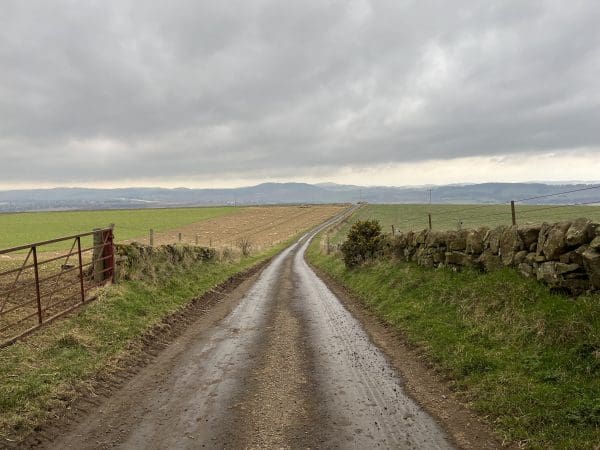
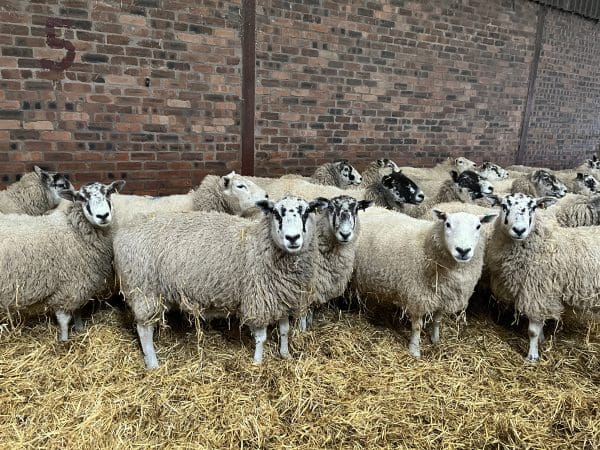
My herd is composed of 500 ewes, five bulls and about 200 cows. There’s a bit of everything – I work with Aberdeen, Angus, Charolais and Simmental. I calf in two groups, April and October, to share the workload. I wouldn’t like to be sowing my crops, lambing my sheep and calving all my cows at the same time, it’s too much in the spring! Once they’re ready, they’ll either be sold to a meat processor in Perth, or go to an auction mart in Stirling.
We like to grow our own crops to rear our own animals, that’s the biggest link to it all. I’ve increased livestock numbers in recent years, to drag use of what we grow. I only use about 10% of it, for feed. We’re keeping a proportion of the feed barley for our own use and all the straw, and we sell all the other cereals and oilseed rape.
If you ask my wife, we’re never finished! Livestock is a big tie; crops are seasonal, but there’s never not something on the go. I’ll start lambing in the last week of march, but even mid-March you’re in the peak of spring, which will take fully two months to get through.
I do part-time contract work on top of this as well, so that’ll take me into the grass season. In the summer months, we’re preparing for winter – it’s green harvest time, and then we’re into cereal harvest. As soon as harvest is finished, we’re sowing for next year’s, and we’re really into it right until winter approaches.
All our cattle are housed indoors, throughout the winter – from October, even though some of them will stay out right through November – so for fully five months, that’s a big part of the workload. So far, we haven’t had any snow, so we’ve done everything that we wanted, but that’s not always the case.
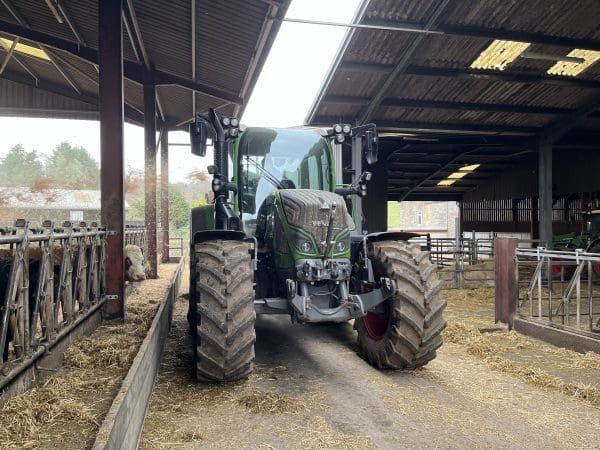

I currently have four Fendt tractors – a 415, two 516 and a 720. The first one we bought was a 818 in 2004, and at the time, compared to what was available on the market, it was a huge step forward. We’ve had eight since then, and I’ve bought the same ones several times in a row.
Evidently, there’s been some good progressions along the way of what Fendt’s done to their own models, but even though my oldest one will be ten this harvest, I’d never jumped on that thing and think it’s a poor tractor. That’s what I always say with Fendt, they still feel new and tight.
“Effortless control is what I’ve gained with the Vario transmission – which comes back to safety.”
From an operator’s point of view, it’s very comfortable. I do a lot of the work myself, so if I’m the one sitting in the seat, I’ll buy what I find the best. My father’s also getting onto an age now, but he’s still heavily relied on, and Fendt would be the biggest help as to what I can still get him to do.
The truth is that my tractors are all very similar. There’s a simple side to the Fendt – things might change in the future, of course, but at present it’s quite reassuring that all the controls feel familiar from one machine to another. For my dad, or if I have part-time helpers, I know I can set up the machine ahead so it’s ready for them to use, and there’s a big safety benefit there, of what a Fendt won’t let them do.
All in all, effortless control is what I’ve gained with the Vario transmission – which comes back to safety. When I’m out spraying in the field, and I come across a telegraph pole, I can fold the sprayer while still driving; likewise, when feeding the cattle, I can put the bale over the door in the shed full of cows using the front loader, with precision. In both these tasks, and many more, I have ultimate control.
Fuel efficiency is also a big one. The newest models out there have got a lot more power, and you’re not getting a bigger tractor. To do the jobs about the yard, process grains and feed my cattle with a feed bruiser, the smaller tractors will only burn six litres an hour. A lot of other farms with different colours of tractors wouldn’t believe that!
We’ve usually been very familiar with what was out there. We’ve always been offered help, or we knew another farmer not far away who bought one, and we were able to speak to them about it.
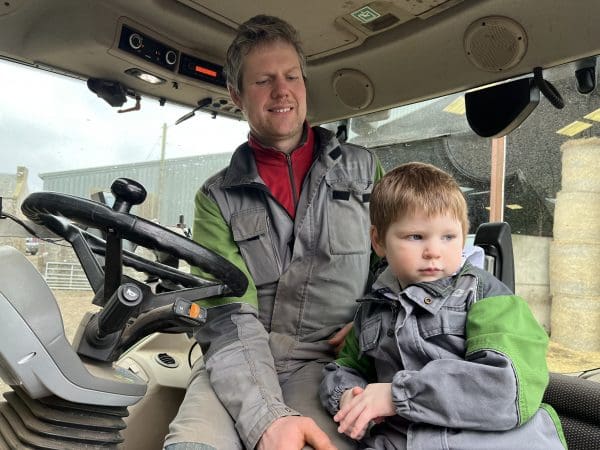
The 516 is all-rounder tractor. It’s a small tractor, but it’s got a good power to weight ratio. It can do the jobs around the buildings, work a six-meter mower in the front and the back, pull a five-furrow plough up and down a big hill – it fits the whole package. We do maybe have extremes for a smaller tractor, but I’ve done it for a lot of years now.
One is fitted with a loader, for feeding livestock, bedding, and mucking sheds for winter. All year round, they’ll be used as a transport in between farms, to the market, etc. With our cattle and sheep flow, there’s never not a period that something’s moving, so that creates quite a lot of work. The 415 will do a similar role to the 516, because that’s another small tractor.
The 720 is an everyday field tractor, so it will do the bulk of cultivating and sowing, and I’ve used it a couple times on the road. To plough 20 to 30 acres in a day is very achievable, and while the output of our bigger tractor is little greater, it would do more days than the smaller one.
In the summer, when the cattle aren’t inside, we’re growing crops, and trying to produce our own winter supplies. When we hit peak season, it’s every tractor on the go – which turns into spreading fertiliser, spraying, and then we get to mowing and harvesting the grass. All this needs to be baled and cleared to allow those fields to be sown again, and we have a Fendt tedder and a Fendt baler for that.
“We’ve got to invest in the right machines, so we can do a job more quickly or more easily.”
Because of the nature of mixed farming, I’ll have my own deadlines to meet. There’ll be other farmers with no livestock, and they’ve got to be ready to go, but I know the day that I’ll get busy, because lambing and calving starts, and everything needs to be fitted around that. I’ve got to find the right balance, during the day – if I take all morning with livestock, and start spreading fertiliser at mid-day, I still have the same area to cover as if I’d started at eight o’clock.
Plus, in Scotland, you’re always battling against the weather. You’re not long in losing quite a considerable amount of time, when you’re out playing catch up, and fighting for dry days. I’m not the only one at it, and that’s maybe the other problem – there’s not the backup locally to ask for help.
There’ll be years where we’ll have more crops sown for the next year ahead’s harvest, that we have harvested from the previous, and that’s when it gets really difficult – when you try to combine bales, cut grains, process that through the dryer, before you’re sowing next year’s.
The biggest issue will always be labour. We’ve got to equip ourselves even better to cope with the lack of staff we’ve now got. We’ve got to invest in the right machines, so we can do a job more quickly or more easily. With the Fendt tedder, and the baler, we’ve gained considerable output.
My grandfather would have been a customer from Reekie, before it became R&R Machinery, all the way through to 1947. They took the Fendt brand on in 2002, we had a demonstration in 2003, and we bought our first Fendt the next year, from Sam Mercer (Sales Manager). I traded it against a new 820 in 2008, this time dealing with Steven.
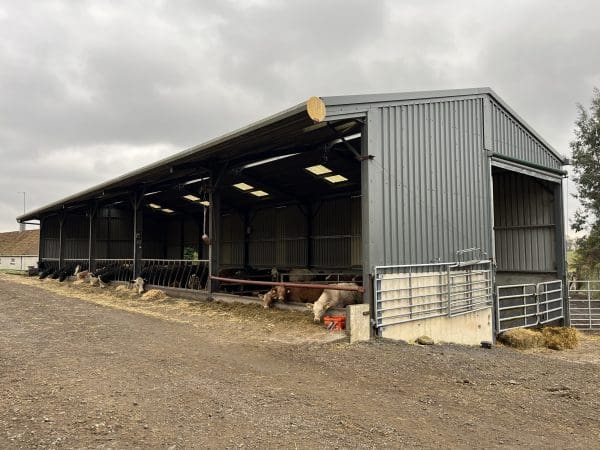
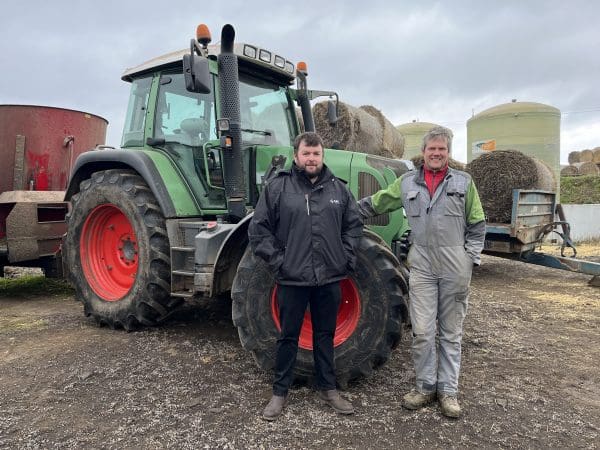
Steven Player & John Whiteford
I’m very local. I farm on both sides of Cupar, and my fields are only ten minutes away from the depot. I’ve always had a good relationship with the Sales, Parts and Service departments. Every machine is going to need attention, whether that’s twelve o’clock on a Saturday, or five at night, and I can always get a quick question answered, or I know I will get help shortly after.
It’s the same if I buy a new machine I’m not familiar with, like two years ago when we bought the Fendt round baler. I don’t know if anybody understands a new machine fully before they get it – especially with the new generation of tractors, which are equipped with GPS and ISOBUS. Both are a huge improvement to the operator’s environment, in terms of productivity and output, but you’re going to need help for the set up if you want to reap the full benefits.
It’s a hard one, I’m happy with what I’ve got. The continuity of the business is assured with my son, Peter, who never tires of wearing his own Fendt boiler suit and playing with his model tractor!
Get in touch with your local R&R Machinery Cupar depot to find out how you can order your own Fendt machine.
If you or someone you know has an interest in a career with the Hamilton Ross Group, please send your CV to [email protected] or visit our Indeed page.
